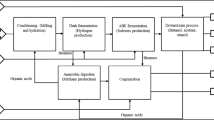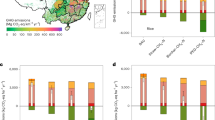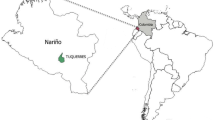Abstract
In the present study, an attempt was made to investigate the potential of some of the major world’s crops, including wheat, corn, rice, barley, sugarcane, sugar beet, potatoes, and oats, to produce biohydrogen. The collectable amount of agricultural residues that could especially be used to produce hydrogen was estimated in Africa, Asia, Central America, Europe, Northern America, Oceania, and South America, and the potential amount of ammonia as the main nitrogen fertilizer was estimated. Double exponential smoothing method was employed to forecast the future crop production and area harvested. It was calculated that about 10.56 (in 2013) and 15.5 (in 2030) Mt of biohydrogen and 59.84 (in 2013) and 85.86 (in 2030) Mt of ammonia could be obtained globally. In addition, the application of biohydrogen from cereal residues to provide their nitrogen requirement was calculated based on the cultivable area. Nitrogen requirements of near 17%, 31%, 12%, and 33% of the global cultivation area of wheat, corn, barley, and rice would be possibly supplied by the collected residues of the same crops, respectively. Eventually, a discussion has been made on the amount of potentially savable natural gas and reduction in greenhouse gas (GHG) emissions and consequent social costs by global development of biohydrogen industries.

Graphical abstract
Global Potential of Biohydrogen production from Crops Residues













Similar content being viewed by others
References
Demirbas A (2009) Global renewable energy projections. Energy Sources, Part B: Economics, Planning, and Policy 4(2):212–224. https://doi.org/10.1080/15567240701620499
Singh S, Jain S, Ps V, Tiwari AK, Nouni MR, Pandey JK, Goel S (2015) Hydrogen: A sustainable fuel for future of the transport sector. Renew Sustain Energy Rev 51:623–633. https://doi.org/10.1016/j.rser.2015.06.040
Bicer Y, Dincer I, Zamfirescu C, Vezina G, Raso F (2016) Comparative life cycle assessment of various ammonia production methods. J Cleaner Prod 135(Supplement C):1379–1395. https://doi.org/10.1016/j.jclepro.2016.07.023
Frattini D, Cinti G, Bidini G, Desideri U, Cioffi R, Jannelli E (2016) A system approach in energy evaluation of different renewable energies sources integration in ammonia production plants. Renew Energy 99(Supplement C):472–482. https://doi.org/10.1016/j.renene.2016.07.040
Bicer Y, Dincer I (2018) Life cycle assessment of ammonia utilization in city transportation and power generation. J Cleaner Prod 170:1594–1601. https://doi.org/10.1016/j.jclepro.2017.09.243
Giddey S, Badwal S, Kulkarni A (2013) Review of electrochemical ammonia production technologies and materials. Int J Hydrogen Energy 38(34):14576–14594
Wang B, Mi Z, Nistor I, Yuan X-C (2018) How does hydrogen-based renewable energy change with economic development? Empirical evidence from 32 countries. Int J Hydrogen Energy 43(25):11629–11638. https://doi.org/10.1016/j.ijhydene.2017.03.059
Vivas FJ, De las Heras A, Segura F, Andújar JM (2018) A review of energy management strategies for renewable hybrid energy systems with hydrogen backup. Renew Sustain Energy Rev 82(Part 1):126–155. https://doi.org/10.1016/j.rser.2017.09.014
Werther J, Saenger M, Hartge EU, Ogada T, Siagi Z (2000) Combustion of agricultural residues. Prog Energy Combust Sci 26(1):1–27. https://doi.org/10.1016/S0360-1285(99)00005-2
Asadi N, Zilouei H (2017) Optimization of organosolv pretreatment of rice straw for enhanced biohydrogen production using Enterobacter aerogenes. Bioresource Technology 227:335–344. https://doi.org/10.1016/j.biortech.2016.12.073
Fixen PE, Johnston AM (2012) World fertilizer nutrient reserves: a view to the future. Journal of the Science of Food and Agriculture 92(5):1001–1005
Asadi N, Karimi Alavijeh M, Zilouei H (2017) Development of a mathematical methodology to investigate biohydrogen production from regional and national agricultural crop residues: A case study of Iran. Int J Hydrogen Energy 42(4):1989–2007. https://doi.org/10.1016/j.ijhydene.2016.10.021
Zhang Q, Wang Y, Zhang Z, Lee D-J, Zhou X, Jing Y, Ge X, Jiang D, Hu J, He C (2017) Photo-fermentative hydrogen production from crop residue: A mini review. Bioresource Technology 229(Supplement C):222–230. https://doi.org/10.1016/j.biortech.2017.01.008
Granovskii M, Dincer I, Rosen MA (2006) Environmental and economic aspects of hydrogen production and utilization in fuel cell vehicles. Journal of Power Sources 157(1):411–421. https://doi.org/10.1016/j.jpowsour.2005.07.044
Cetinkaya E, Dincer I, Naterer GF (2012) Life cycle assessment of various hydrogen production methods. Int J Hydrogen Energy 37(3):2071–2080. https://doi.org/10.1016/j.ijhydene.2011.10.064
Djomo SN, Blumberga D (2011) Comparative life cycle assessment of three biohydrogen pathways. Bioresource Technology 102(3):2684–2694. https://doi.org/10.1016/j.biortech.2010.10.139
Food and Agriculture Organization of the United Nations, Statistics Division (2016) http://faostat3.fao.org/browse/Q/QC/E. Accessed 07.06.16
Appl M (2000) Ammonia. In: Elvers B HSea (ed) Ullmann's Encyclopedia of Industrial Chemistry. Wiley-VCH Verlag GmbH & Co. KgaA. https://doi.org/10.1002/14356007.a02_143.pub2
Karimi Alavijeh M, Yaghmaei S (2016) Biochemical production of bioenergy from agricultural crops and residue in Iran. Waste Management 52:375–394. https://doi.org/10.1016/j.wasman.2016.03.025
Kim S, Dale BE (2004) Global potential bioethanol production from wasted crops and crop residues. Biomass Bioenerg 26(4):361–375. https://doi.org/10.1016/j.biombioe.2003.08.002
Hewu W, Haiyan H, Xue D, Minggao O (2013) Hydrogen and fuel-cell vehicle technology. Sustainable automotive energy system in China. Springer, Berlin, pp 301–333. https://doi.org/10.1007/978-3-642-36847-9_10
Dincer I, Joshi AS (2013) Case studies. Solar based hydrogen production systems. Springer, New York, pp 91–119. https://doi.org/10.1007/978-1-4614-7431-9_7
Simons A, Bauer C (2011) Life cycle assessment of hydrogen production. In: Wokaun A, Wilhelm E (eds) Transition to hydrogen: Pathways toward clean transportation. Cambridge University Press, pp 13-57
IEA (2007) IEA Energy Technology Essentials - Hydrogen Production and Distribution International Energy Agency
Sharif A (2012) Modelling of a Natural-Gas-Based Clean Energy Hub. Waterloo
Chen H, Li X, Hu F, Shi W (2013) Soil nitrous oxide emissions following crop residue addition: a meta-analysis. Global Change Biology 19(10):2956–2964. https://doi.org/10.1111/gcb.12274
Hignett TP (1985) Production of Ammonia. In: Hignett TP (ed) Fertilizer Manual. Springer Netherlands, Dordrecht, pp 49–72. https://doi.org/10.1007/978-94-017-1538-6_6
Overend R aWL (2007) Biomass Energy. In: Goswami DY, Kreith F (eds) Energy Conversion. CRC Press, pp 1-17
Calvo-Flores FG, Dobado JA, Isac-García J, Martín-MartíNez FJ (2015) Functional and Spectroscopic Characterization of Lignins. Lignin and Lignans as Renewable Raw Materials. John Wiley & Sons, Ltd, pp 145-188. https://doi.org/10.1002/9781118682784.ch6
Littler J, Thomas R (1984) Watersupply systems Design with Energy: The Conservation and Use of Energy in Buildings. Cambridge University Press, pp 289-303
Singh A, Rathore D (2017) Biohydrogen Production: Sustainability of Current Technology and Future Perspective. Springer
Mankins JC (2009) Technology readiness assessments: A retrospective. Acta Astronautica 65(9):1216–1223. https://doi.org/10.1016/j.actaastro.2009.03.058
Lopez-Hidalgo AM, Sánchez A, De León-Rodríguez A (2017) Simultaneous production of bioethanol and biohydrogen by Escherichia coli WDHL using wheat straw hydrolysate as substrate. Fuel 188(Supplement C):19–27. https://doi.org/10.1016/j.fuel.2016.10.022
Muharja M, Junianti F, Ranggina D, Nurtono T, Widjaja A (2018) An integrated green process: Subcritical water, enzymatic hydrolysis, and fermentation, for biohydrogen production from coconut husk. Bioresource Technology 249(Supplement C):268–275. https://doi.org/10.1016/j.biortech.2017.10.024
Hu B-B, Zhu M-J (2017) Enhanced hydrogen production and biological saccharification from spent mushroom compost by Clostridium thermocellum 27405 supplemented with recombinant β-glucosidases. Int J Hydrogen Energy 42(12):7866–7874. https://doi.org/10.1016/j.ijhydene.2017.01.031
Corneli E, Adessi A, Dragoni F, Ragaglini G, Bonari E, De Philippis R (2016) Agroindustrial residues and energy crops for the production of hydrogen and poly-β-hydroxybutyrate via photofermentation. Bioresource Technology 216 (Supplement C):941-947. https://doi.org/10.1016/j.biortech.2016.06.046
Sindhu R, Gnansounou E, Binod P, Pandey A (2016) Bioconversion of sugarcane crop residue for value added products – An overview. Renew Energy 98(Supplement C):203–215. https://doi.org/10.1016/j.renene.2016.02.057
Yang G, Wang J (2019) Ultrasound combined with dilute acid pretreatment of grass for improvement of fermentative hydrogen production. Bioresourcetechnology 275:10–18
Yang G, Wang J (2019) Synergistic enhancement of biohydrogen production from grass fermentation using biochar combined with zero-valent iron nanoparticles. Fuel 251:420–427
Tandon M, Thakur V, Tiwari KL, Jadhav SK (2018) Enterobacter ludwigii strain IF2SW-B4 isolated for bio-hydrogen production from rice bran and deoiled rice bran. Environmental technology & innovation 10:345–354
Zhu S, Zhang Z, Li Y, Tahir N, Liu H, Zhang Q (2018) Analysis of shaking effect on photo-fermentative hydrogen production under different concentrations of corn stover powder. Int J Hydrogen Energy 43(45):20465–20473
da Silva Mazareli RC, Sakamoto IK, Silva EL, Varesche MBA (2019) Bacillus sp. isolated from banana waste and analysis of metabolic pathways in acidogenic systems in hydrogen production. Journal of Environmental Management 247:178–186
Lu C, Zhang Z, Ge X, Wang Y, Zhou X, You X, Liu H, Zhang Q (2016) Bio-hydrogen production from apple waste by photosynthetic bacteria HAUM1. Int J Hydrogen Energy 41(31):13399–13407
Antonopoulou G, Vayenas D, Lyberatos G (2016) Ethanol and hydrogen production from sunflower straw: The effect of pretreatment on the whole slurry fermentation. Biochemical engineering journal 116:65–74
Ozmihci S (2017) Performance of batch solid state fermentation for hydrogen production using ground wheat residue. Int J Hydrogen Energy 42(37):23494–23499
Mishra P, Ameen F, Zaid RM, Singh L, Ab Wahid Z, Islam MA, Gupta A, Al Nadhari S (2019) Relative effectiveness of substrate-inoculum ratio and initial pH on hydrogen production from palm oil mill effluent: Kinetics and statistical optimization. J Cleaner Prod 228:276–283
Eker S, Erkul B (2018) Biohydrogen production by extracted fermentation from sugar beet. Int J Hydrogen Energy 43(23):10645–10654
Parthasarathy P, Narayanan KS (2014) Hydrogen production from steam gasification of biomass: influence of process parameters on hydrogen yield–a review. Renew Energy 66:570–579
Acar C, Dincer I (2014) Comparative assessment of hydrogen production methods from renewable and non-renewable sources. Int J Hydrogen Energy 39(1):1–12
Khan MA, Ngo HH, Guo W, Liu Y, Zhang X, Guo J, Chang SW, Nguyen DD, Wang J (2017) Biohydrogen production from anaerobic digestion and its potential as renewable energy. Renew Energy
Bhandari R, Trudewind CA, Zapp P (2014) Life cycle assessment of hydrogen production via electrolysis–a review. J Cleaner Prod 85:151–163
Hwang J-J (2013) Sustainability study of hydrogen pathways for fuel cell vehicle applications. Renew Sustain Energy Rev 19:220–229
Yilmaz C, Kanoglu M, Bolatturk A, Gadalla M (2012) Economics of hydrogen production and liquefaction by geothermal energy. Int J Hydrogen Energy 37(2):2058–2069
Dowaki K, Ohta T, Kasahara Y, Kameyama M, Sakawaki K, Mori S (2007) An economic and energy analysis on bio-hydrogen fuel using a gasification process. Renew Energy 32(1):80–94
Sathyaprakasan P, Kannan G (2015) Economics of bio-hydrogen production. International Journal of Environmental Science and Development 6(5):352
Sattar A, Arslan C, Ji C, Sattar S, Umair M, Sattar S, Bakht MZ (2016) Quantification of temperature effect on batch production of bio-hydrogen from rice crop wastes in an anaerobic bio reactor. Int J Hydrogen Energy 41(26):11050–11061. https://doi.org/10.1016/j.ijhydene.2016.04.087
Zhang Q, Lu C, Lee D-J, Lee Y-J, Zhang Z, Zhou X, Hu J, Wang Y, Jiang D, He C, Zhang T (2017) Photo-fermentative hydrogen production in a 4m3 baffled reactor: Effects of hydraulic retention time. Bioresource Technology 239(Supplement C):533–537. https://doi.org/10.1016/j.biortech.2017.05.067
Pasupuleti SB, Sarkar O, Venkata Mohan S (2014) Upscaling of biohydrogen production process in semi-pilot scale biofilm reactor: Evaluation with food waste at variable organic loads. Int J Hydrogen Energy 39(14):7587–7596. https://doi.org/10.1016/j.ijhydene.2014.02.034
Lee H-S, Vermaas WF, Rittmann BE (2010) Biological hydrogen production: prospects and challenges. Trends Biotechnol 28(5):262–271
Kumar G, Sivagurunathan P, Sen B, Mudhoo A, Davila-Vazquez G, Wang G, Kim S-H (2017) Research and development perspectives of lignocellulose-based biohydrogen production. International Biodeterioration & Biodegradation 119(Supplement C):225–238. https://doi.org/10.1016/j.ibiod.2016.10.030
Rezania S, Din MFM, Taib SM, Sohaili J, Chelliapan S, Kamyab H, Saha BB (2017) Review on fermentative biohydrogen production from water hyacinth, wheat straw and rice straw with focus on recent perspectives. Int J Hydrogen Energy 42(33):20955–20969. https://doi.org/10.1016/j.ijhydene.2017.07.007
Brentner LB, Peccia J, Zimmerman JB (2010) Challenges in developing biohydrogen as a sustainable energy source: implications for a research agenda. Environmental science & technology 44(7):2243–2254
Sharma M, Kaushik A (2017) Biohydrogen Economy: Challenges and Prospects for Commercialization. Biohydrogen Production: Sustainability of Current Technology and Future Perspective. Springer, pp 253-267
Oliveira-Lopes LC, da Silva CHF (2014) Nonconventional Renewable Sources in Brazil and Their Impact on the Success of Bioenergy. In: da Silva SS, Chandel KA (eds) Biofuels in Brazil: Fundamental Aspects, Recent Developments, and Future Perspectives. Springer International Publishing, Cham, pp 413–435. https://doi.org/10.1007/978-3-319-05020-1_19
Dincer I, Acar C (2017) Innovation in hydrogen production. Int J Hydrogen Energy 42(22):14843–14864. https://doi.org/10.1016/j.ijhydene.2017.04.107
Asadi N, Karimi Alavijeh M, Zilouei H (2018) Biological hydrogen production by Enterobacter aerogenes: Structural analysis of treated rice straw and effect of substrate concentration. Int J Hydrogen Energy 43(18):8718–8728. https://doi.org/10.1016/j.ijhydene.2018.03.137
Author information
Authors and Affiliations
Corresponding author
Additional information
Publisher’s Note
Springer Nature remains neutral with regard to jurisdictional claims in published maps and institutional affiliations.
Rights and permissions
About this article
Cite this article
Karimi Alavijeh, M., Yaghmaei, S. & Mardanpour, M.M. Assessment of Global Potential of Biohydrogen Production from Agricultural Residues and Its Application in Nitrogen Fertilizer Production. Bioenerg. Res. 13, 463–476 (2020). https://doi.org/10.1007/s12155-019-10046-1
Published:
Issue Date:
DOI: https://doi.org/10.1007/s12155-019-10046-1




